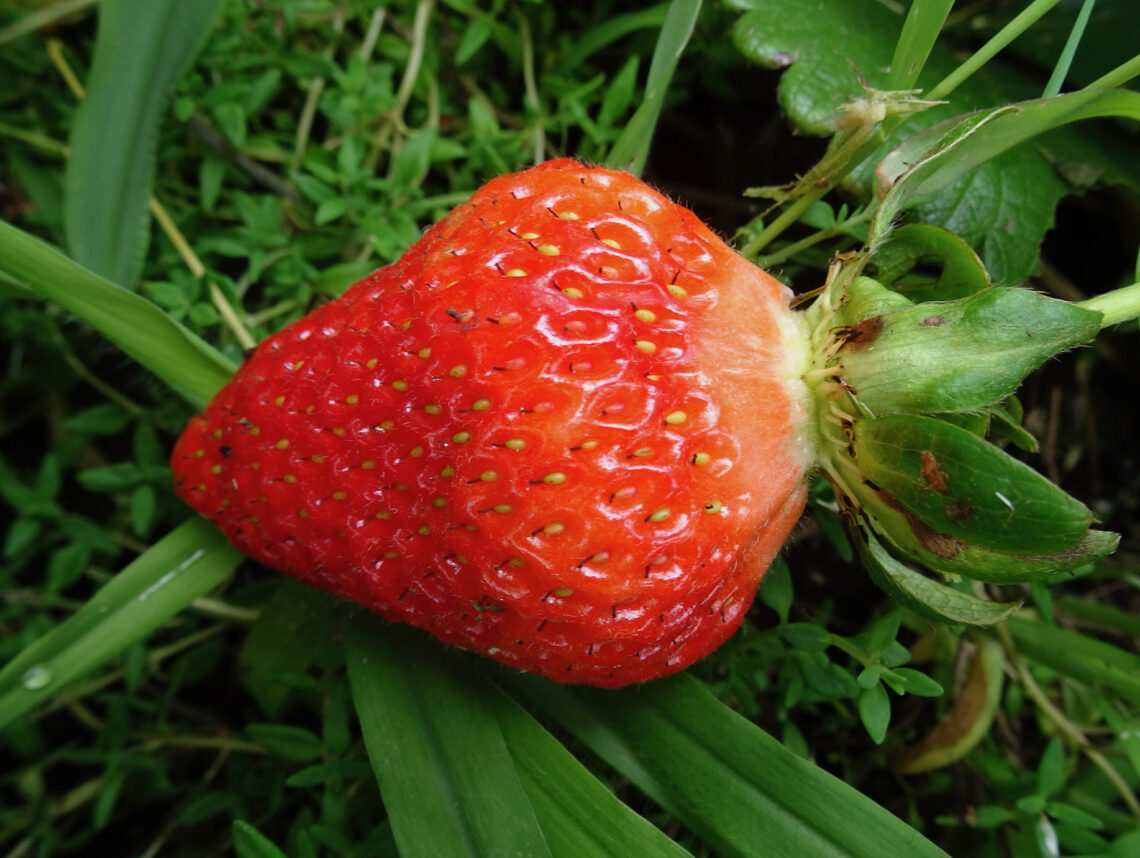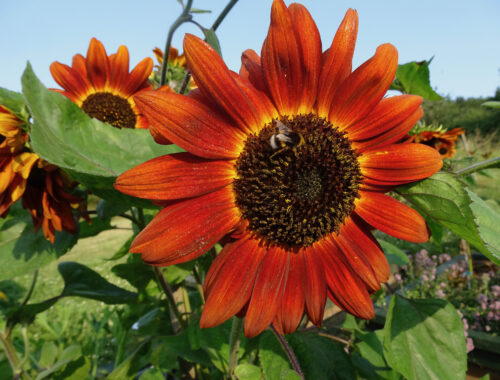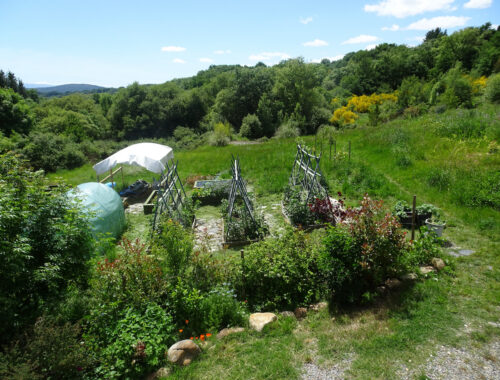
Strawberry Yields Forever
Why grow your own strawberries?
We have dedicated one of our seven raised beds entirely to strawberries and I feel happier with every berry we eat. Strawberries can be a superfood rich in health-promoting compounds like folic acid, vitamin C, fiber, anthocyanins and quercetin. However, all commercially-grown strawberries are not only tasteless, but come with a free lucky-dip pesticide cocktail, meaning that you never know which pesticides, how many of them or how much of each is in your punnet.
Pesticides and fungicides fall into three groups in regard to their effects on humans:
- carcinogenic
- hormone disruptors
- neurotoxin
Additionally, these pesticides are harmful to bees and other pollinators, as well as fish and amphibians as they find their way into the waters and the food chain.
There is no real ‘protection’ for the consumer as the immediate or long-term effects of any group combinations of these poisons are completely unknown. The regulations regarding the use of pesticides and fungicides are designed to serve the chemical companies, rather than the consumer. Tellingly, some of the chemicals that are legal in the USA are banned in Europe and vice versa, because our constitutions are so different, obviously!
Here are a few examples:
Pesticides commonly used on strawberries and found in many tested samples include:
Carbendazim, used in the US and found in strawberries, is a hormone-disrupting fungicide that damages the male reproductive system. It is banned in the EU because of safety concerns.
Captan is a fungicide and ‘probable human carcinogen’ that is legal for use in greenhouses in Europe and illegal in the USA. Nearly half of strawberries sampled in Europe were found to contain Captan residue.
Clorpyrifos is an organophoshate insecticide and a neurotoxin that is capable of causing serious brain damage to the unborn. It is legal in both the US and the EU and the residues found often exceed legal limits.
Glyphosate (Roundup) is banned in more than 20 countries, because it is a ‘probable carcinogen’ linked to an increased risk of non-Hodgkin lymphoma and other types of cancer. It is legal in the US and Europe and the residue is often found on strawberries. In addition to the cancer risk, glyphosate kills beneficial gut bacteria, interferes with the liver enzymes involved in activating vitamin D and reduces the bodies ability to detoxify. It also accumulates in biofilms in the rivers and poisons fish and amphibians.
Graphene oxide is one of the chemicals used in aerial spraying and I have found it in our rainwater. Initially I was alarmed, but after looking into it further, yes, it’s another toxic substance that we don’t need but it’s nothing to be afraid of, unless you have injected it into your body. It is much more harmful to the respiratory system than if ingested. It is water soluble and easily broken down by rain and through the usual detox pathways in the body.
Nanoparticles are being used in pesticides, herbicides, fungicides and fertilizers and marketed as new ways of improving disease resistance and crop yield for ‘food security’ and ‘sustainable agriculture’. This is just another scam, they are the same chemicals, made by the same companies, just smaller. It’s part of the agenda to get farmers to buy more chemicals to deplete the soil, so they need more chemicals, to destroy the soil to make us eat lab-grown ‘meat’ with chemicals, oh and insects. More profits for chemical companies at the expense of life.
Organic strawberries do have less residue, but are not completely chemical free. This is because some pesticides and fungicides are allowed within the organic certification scheme and because they might be grown in proximity to commercially sprayed crops.
The residues cannot be washed off completely, as strawberries are so delicate.
That’s not the only issue: have you noticed that strawberries don’t taste like they used to when you were a kid? That’s not your memory playing tricks on you. The mineral content and fibre content of strawberries is now significantly less than it used to be.
This is the percentage of key minerals and fibre in strawberries today, as compared to 1980s data.
- Calcium – 16%
- Magnesium – 10%
- Iron – 0.4%
- Copper – 0.7%
- Sodium – 6%
- Phosphorus – 24%
- Fibre – 10.5%
Potassium has gone up to 160% and water is at 88%. Potassium is essential for sweetness in strawberries, but increased potassium and a reduced fibre to water ratio make for sweet watery berries without that unique strawberry flavour.
We decided that, all in all, store-bought strawberries were both always disappointing and an unnecessary health risk, so we stopped buying them several years ago. Life without strawberries is not the end of the world but, as we have the space and the climate, we decided to grow our own. They are very easy to grow and they are so delicious that they cannot be anything but a superfood.
Health benefits of organic home-grown strawberries
The health benefits of home-grown organic strawberries:
- Eye health: high in vitamin C and eating regularly can help prevent macular degeneration
- Boost short term memory: they are one of the best-known sources of numerous anthocyanins and phenolic antioxidants. Anthocyanins can boost short-term memory by 100% in eight weeks, according to the The Journal of Agricultural and Food Chemistry.
- Heart health: flavonoids, which are responsible for the colour and flavour of the strawberry, and anthocyanins have been found to lower the risk of myocardial infarction
- Bone health: contain potassium, vitamin K, and magnesium
- Promote youthfulness: contain biotin, for strong hair and nails and the antioxidant ellagic acid, which protect the elastic fibers in the skin
- Cancer prevention: ellagic acid and the antioxidants lutein and zeathancins help reducecell damage associated with cancer. (Note: cancer is not a specific disease, but a name given to a collection of symptoms arising out of trauma, poisoning and malnutrition.)
Strawberry plant care
It’s now early spring and the plants are just emerging from their winter sleep. I’m no expert on strawberry plant care. There are apparently three types of strawberry plant, June fruiting, which bear fruit for two-three weeks around June. Ever-bearing, produce in June and again later in the year, but with smaller fruits and smaller yields. Day-neutral, are said to produce small fruits throughout the year, but very few of them, less than for either of the other two types. They only sell one type of strawberry plant here and you get a blank look if you ask what type. So far, they have produced a steady supply of large, medium and small fruits from May/June to October, more than enough for us, although less when it’s too hot.
I give them a good mulching with our compost, that is a mix of kitchen waste, grass clippings, chicken manure and biochar, in the autumn and spring. Aged chicken manure is great for strawberries,high in the basic requirements of nitrogen, phosphorus and potassium that the plants need for growth
Epsom salts – this is magnesium-sulfate, both of which help strawberry plants produce flowers and fruits. I will give them one or two waterings, with a tablespoon of epsom salts in the watering can before they start flowering and again at the end of the season.
Banana peels – banana peels soaked I water for a few days are an excellent source of potassium for strawberries, which they need to produce sweetness, as well as healthy growth. I’ve found that it’s best to give them banana peel water before flowering and fruiting, so I’ll be starting that as soon as I have some bananas.
Coffee grounds – coffee grounds acidify the soil and strawberries like acid soil. In the autumn-winter, our coffee grounds go directly into the compost. In spring and summer, I keep them aside and top dress the plants every now and then.
Egg shells – I use crushed egg shells to deter pests, and put them around plants regularly throughout the growing season. This ensures calcium availability throughout the year.
Copper – I have been using copper sulfate as an anti-fungicide for a few years. However, it is likely that its ‘anti-fungal’ properties are actually because it catalyses many growth processes – fungus occurs once entropic processes have already begun. This year I’m going to use electro-culture, with copper antennas. There are many accounts of electro-culture replacing the need for fertilizer, which is beginning to make sense to me and I’m going to experiment with it this year.
Strawberries grow well in raised beds, like ours, or in containers if you only have a small space or need to bring them in for winter.

Activating the TreeG Network
You May Also Like

Hay making
July 16, 2013
What we grow in a year
September 13, 2023

